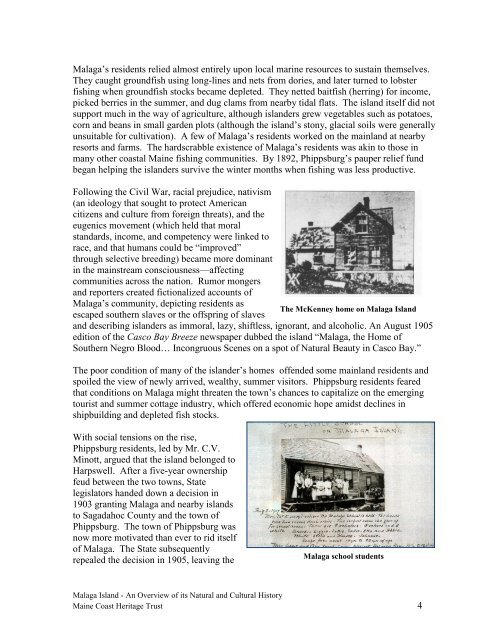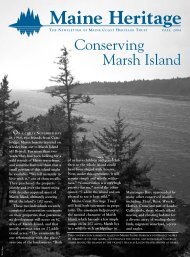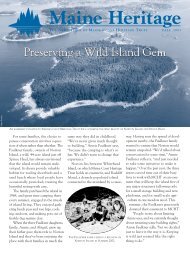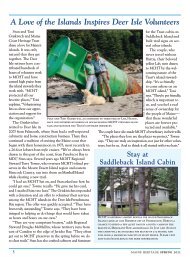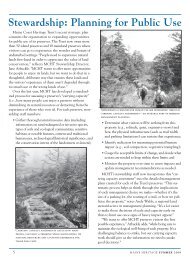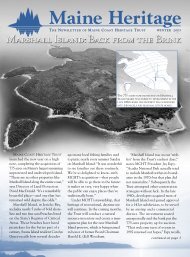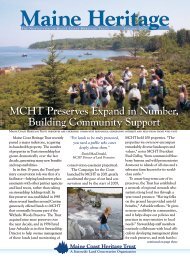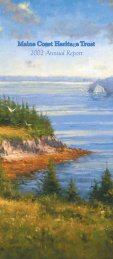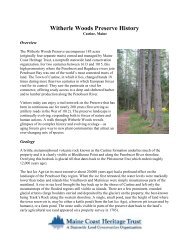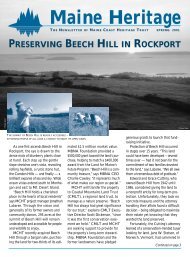Malaga Island - Maine Coast Heritage Trust
Malaga Island - Maine Coast Heritage Trust
Malaga Island - Maine Coast Heritage Trust
You also want an ePaper? Increase the reach of your titles
YUMPU automatically turns print PDFs into web optimized ePapers that Google loves.
<strong>Malaga</strong>’s residents relied almost entirely upon local marine resources to sustain themselves.<br />
They caught groundfish using long-lines and nets from dories, and later turned to lobster<br />
fishing when groundfish stocks became depleted. They netted baitfish (herring) for income,<br />
picked berries in the summer, and dug clams from nearby tidal flats. The island itself did not<br />
support much in the way of agriculture, although islanders grew vegetables such as potatoes,<br />
corn and beans in small garden plots (although the island’s stony, glacial soils were generally<br />
unsuitable for cultivation). A few of <strong>Malaga</strong>’s residents worked on the mainland at nearby<br />
resorts and farms. The hardscrabble existence of <strong>Malaga</strong>’s residents was akin to those in<br />
many other coastal <strong>Maine</strong> fishing communities. By 1892, Phippsburg’s pauper relief fund<br />
began helping the islanders survive the winter months when fishing was less productive.<br />
Following the Civil War, racial prejudice, nativism<br />
(an ideology that sought to protect American<br />
citizens and culture from foreign threats), and the<br />
eugenics movement (which held that moral<br />
standards, income, and competency were linked to<br />
race, and that humans could be ―improved‖<br />
through selective breeding) became more dominant<br />
in the mainstream consciousness—affecting<br />
communities across the nation. Rumor mongers<br />
and reporters created fictionalized accounts of<br />
<strong>Malaga</strong>’s community, depicting residents as<br />
The McKenney home on <strong>Malaga</strong> <strong>Island</strong><br />
escaped southern slaves or the offspring of slaves<br />
and describing islanders as immoral, lazy, shiftless, ignorant, and alcoholic. An August 1905<br />
edition of the Casco Bay Breeze newspaper dubbed the island ―<strong>Malaga</strong>, the Home of<br />
Southern Negro Blood… Incongruous Scenes on a spot of Natural Beauty in Casco Bay.‖<br />
The poor condition of many of the islander’s homes offended some mainland residents and<br />
spoiled the view of newly arrived, wealthy, summer visitors. Phippsburg residents feared<br />
that conditions on <strong>Malaga</strong> might threaten the town’s chances to capitalize on the emerging<br />
tourist and summer cottage industry, which offered economic hope amidst declines in<br />
shipbuilding and depleted fish stocks.<br />
With social tensions on the rise,<br />
Phippsburg residents, led by Mr. C.V.<br />
Minott, argued that the island belonged to<br />
Harpswell. After a five-year ownership<br />
feud between the two towns, State<br />
legislators handed down a decision in<br />
1903 granting <strong>Malaga</strong> and nearby islands<br />
to Sagadahoc County and the town of<br />
Phippsburg. The town of Phippsburg was<br />
now more motivated than ever to rid itself<br />
of <strong>Malaga</strong>. The State subsequently<br />
repealed the decision in 1905, leaving the<br />
<strong>Malaga</strong> school students<br />
<strong>Malaga</strong> <strong>Island</strong> - An Overview of its Natural and Cultural History<br />
<strong>Maine</strong> <strong>Coast</strong> <strong>Heritage</strong> <strong>Trust</strong> 4


